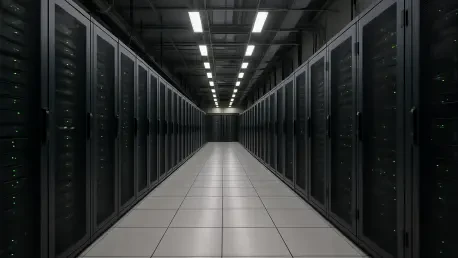The rapid expansion of data centers across the Mid-Atlantic and Midwest regions has sent shockwaves through the energy sector, particularly within the PJM Interconnection, a regional transmission organization serving parts of 13 states and the District of Columbia. According to a recent report by Monitoring Analytics, PJM’s market monitor, the unprecedented surge in energy demand from these facilities has emerged as the leading cause of soaring capacity auction prices, placing significant financial pressure on electricity consumers. This escalating trend not only highlights the growing tension between technological advancement and grid stability but also raises critical questions about how to manage such concentrated load growth without compromising affordability for other users. As data centers become integral to modern infrastructure, their energy consumption is reshaping capacity markets in ways that demand urgent attention and innovative solutions from policymakers and stakeholders alike.
Understanding the Financial Impact
Auction Revenues Soar Due to Data Center Demand
The financial implications of data center growth on PJM’s capacity market are staggering, with recent auctions revealing just how much this sector is driving costs upward. In the latest capacity auction, data center demand accounted for a remarkable $7.3 billion, representing 82% of the total $16.1 billion in revenue. When combined with figures from the previous auction, the load from both existing and projected data centers contributed $16.6 billion, nearly half of the $30.8 billion amassed across the two events. These auctions, designed to secure future power supplies, have seen capacity prices spike dramatically, directly translating into double-digit bill increases for some utility customers in the region. This sharp rise in costs underscores that the current market dynamics are not driven by typical organic growth but by the specific, intense demands of large-scale data center operations, creating a ripple effect that impacts millions of consumers across the PJM footprint.
Consumer Costs and Price Caps as Temporary Relief
Beyond the auction revenues, the burden on consumers extends to additional expenses tied to infrastructure and market mechanisms influenced by data center proliferation. A separate analysis from the Union of Concerned Scientists highlights that utility ratepayers in PJM are shouldering approximately $4.4 billion in costs for data center-related transmission projects approved recently, with similar expenditures expected in the near term. Meanwhile, price caps have offered some respite, as noted by the market monitor, with a cap negotiated with Pennsylvania Governor Josh Shapiro saving an estimated $3.2 billion, or 20%, in the last auction. However, these caps are set to expire before the capacity auction for 2028/2029, raising concerns about potential price surges if data center demand continues unabated. This temporary measure reveals the fragility of current cost containment strategies and the pressing need for more permanent solutions to shield consumers from the financial fallout of this industry’s rapid expansion.
Addressing the Challenges of Data Center Growth
Policy Proposals to Mitigate Grid Strain
In response to the mounting challenges posed by data center energy demands, significant policy reforms have been put forward to alleviate pressure on the PJM grid and protect other electricity users. Monitoring Analytics has suggested a bold approach, advocating that new data centers be required to supply their own generation rather than drawing from existing PJM power resources. Such a mandate could prevent the operational and financial strain caused by unpredictable load growth from impacting the broader consumer base. Additionally, PJM is fast-tracking a stakeholder process to develop new integration rules for large data centers, with a proposal slated for submission to the Federal Energy Regulatory Commission by the end of this year. These reforms aim to establish a framework that balances the needs of data centers with the stability of the grid, ensuring that the energy infrastructure can adapt to this unprecedented demand without compromising reliability or affordability for all users.
Enhanced Forecasting and Financial Safeguards
Another critical focus in managing data center growth lies in improving load forecasting and implementing financial protections to stabilize the capacity market. PJM’s proposed changes include refining load predictions specifically for data centers and other large loads, involving state utility commissions in the review process to enhance accuracy. There’s also a push for utilities to scrutinize potential duplicative data center proposals within their jurisdictions to avoid overestimating demand. Furthermore, large load customers might be required to post financial security for the capacity they plan to procure, a measure intended to mitigate risks associated with uncertain forecasts. The market monitor has pointed out that attributing tight market conditions solely to supply-demand dynamics is misleading when data center expansion is the dominant factor. These steps reflect a concerted effort to bring clarity and accountability to a market grappling with the unique pressures of a single, energy-intensive industry, aiming to prevent further cost escalations for ratepayers.
Reflecting on Past Interventions and Future Risks
Looking back, the interventions and responses to the data center-driven capacity price surge in PJM revealed both temporary successes and looming challenges that demand attention. The implementation of price caps in recent auctions managed to curb immediate cost spikes, providing a buffer for consumers against the full brunt of data center demand. Yet, the expiration of these caps before the 2028/2029 auction cycle poses a significant risk, as unchecked demand could drive prices even higher. Additionally, the substantial costs borne by ratepayers for transmission infrastructure underscore the broader financial implications that have yet to be fully addressed. As PJM and stakeholders navigate these complexities, the abandonment of controversial proposals like non-capacity-backed load shows a willingness to adapt based on feedback. Moving forward, the emphasis needs to shift toward sustainable policies—such as mandating self-generation for data centers and refining forecasting models—to ensure grid reliability and equitable cost distribution, setting a precedent for other regions facing similar pressures.









